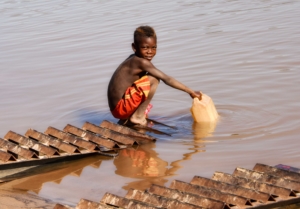10 Facts about Sanitation in South Africa

South Africa, the southernmost country in Africa, is home to over 58 million people and recognizes 11 official languages. People also often refer to it as the “rainbow nation” for its wide diversity in culture. Today, people often link South Africa to its challenges with water supply and sanitation, and conversely, its recent achievements in both categories. Here are 10 facts about sanitation in South Africa.
10 Facts About Sanitation in South Africa
- Access to clean water is scarce. Droughts, infrequent rainfall and a shortage of resources are all causes of South Africa’s water crisis. In 2008, 5 million South Africans reported lacking access to safe, drinkable water. While this number has steadily declined over the years, with an improved 88.8 percent of households having access to piped water in 2016, some rural regions must rely on groundwater alone to meet their needs.
- Sanitation is slowly improving. While the rate of improving sanitation is still slow, about 82 percent of households recorded having access to either flush toilets or ventilated pits in 2017. This is a 20 percent increase since 2002, meaning lives are improving. Thanks to the volunteer work and successful methods of several NGO projects like AMREF and WaterAid, more and more people are gaining access to clean water and reliable toilets.
- Rural areas suffer the greatest lack of water. Dams supply a majority of the water in South Africa’s urban cities; however, rural areas often have to depend on rainfall that is becoming increasingly sporadic. Lack of water facilities has caused 74 percent of rural South Africans to be entirely dependent on groundwater that is often unclean. Additionally, the growing rural population is causing even more strain on the water crisis; 19 percent of people did not have a reliable source of clean water in 2006.
- Poor sanitation compromises clean water. Several major rivers stretch through South Africa, but sewage waste often contaminates its waters. Outdated infrastructure, poor management and lack of resources contribute to the contamination, rendering the water undrinkable and a public health risk. Contact with the contaminated water could lead to waterborne illness or death.
- Waterborne illnesses are still a threat. With large amounts of water contaminated with effluent, the risk of contracting a waterborne disease remains high. Waterborne illnesses affected 60 percent of the country’s rural regions in 2005. In 2008, high volumes of deadly bacteria, including E. Coli, were in the water supply on the southern coast, most likely caused by human waste contamination. However, through improving infrastructure and allowing better access to safe, drinkable water, organizations like AMREF have decreased the rate of child mortality due to waterborne illnesses.
- There is a Free Basic Water Access policy. South Africa is one of the few countries to explicitly state in its constitution that every citizen has an entitlement to a certain amount of free water. The Free Basic Water Access policy that is currently in place highlights this constitutional right, yet the South African Department of Water Affairs and Forestry does not properly monitor water usage and the country loses well over 20 percent of all available water supply due to damaged or broken pipes.
- Shared toilet facilities can be unsafe. Households that use shared toilet facilities often face unsafe conditions. Sixteen percent of households reported having their physical safety threatened in these facilities, and 24 percent complained of poor, unsafe lighting. Poor hygiene, lack of water and lack of maintenance in these shared facilities only attribute to the health risks of communities.
- There was a water crisis in Cape Town. The Cape Town Water Crisis was an extreme water shortage from 2017-2018 that caused the South African government to place water restrictions on citizens in an effort to conserve water supply. The term ‘Day Zero’ shocked the world when Cape Town officials declared that the city of 4 million people would be completely out of water in just three short months. Fortunately, through the allocation of water, tariffs and stricter enforcement, the South African city was able to pull itself out of the crisis and change its ways to avoid another ‘Day Zero’ in the future.
- Poor facilities are compromising girls’ education. Many South African girls and women find themselves unable to manage their menstruation in a safe, private place. Often times, school-aged girls miss out on their education because of the lack of clean, private restrooms at school. Out of 130 schools, 82 percent of students said the school facilities were not sufficiently private. This means that girls are missing school because of the humiliating conditions. In an effort to combat this dilemma, organizations like WaterAid are installing decent, private toilets in schools so girls can better manage their periods.
- NGO projects, like WaterAid, are helping. There are many nonprofits that are striving to improve the country’s situation. WaterAid, founded in 1981, is working to help solve South Africa’s sanitation issue. WaterAid teams with other projects to implement clean water, flush toilets and increased hygiene across the country. In 2016, WaterAid was able to provide 24.9 million people access to clean water, 24 million with safe toilets and 16.7 million with increased sanitation.
While these 10 facts about sanitation in South Africa show that the country still has several measures to make in terms of upholding human dignity, cleanliness and safety, its government and several organizations are taking action. With the help of these projects, improvements are happening every day as the country continues to take steps towards a cleaner, safer future.
– Hadley West
Photo: Flickr
